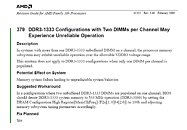- Joined
- Oct 9, 2007
- Messages
- 47,300 (7.53/day)
- Location
- Hyderabad, India
| System Name | RBMK-1000 |
|---|---|
| Processor | AMD Ryzen 7 5700G |
| Motherboard | ASUS ROG Strix B450-E Gaming |
| Cooling | DeepCool Gammax L240 V2 |
| Memory | 2x 8GB G.Skill Sniper X |
| Video Card(s) | Palit GeForce RTX 2080 SUPER GameRock |
| Storage | Western Digital Black NVMe 512GB |
| Display(s) | BenQ 1440p 60 Hz 27-inch |
| Case | Corsair Carbide 100R |
| Audio Device(s) | ASUS SupremeFX S1220A |
| Power Supply | Cooler Master MWE Gold 650W |
| Mouse | ASUS ROG Strix Impact |
| Keyboard | Gamdias Hermes E2 |
| Software | Windows 11 Pro |
Barely a week into the introduction of the DDR3-supportive AM3 socket CPUs, the processors seem to be having design flaws. This, as circulated by AMD in its revision guide document for the 10h family of processors (found here, page 80). The issue, as described by AMD, centers around the DDR3 memory sub-system. On machines with more than one PC3-10600 (1333 MHz) memory module populating a memory channel, the users may experience unreliable operation. The company does not get into the specifics of the symptoms. This issue however, does not affect systems with a module per channel (one or two modules installed in the motherboard), and only those with three to four modules installed.
The AMD K10 memory controllers on AM3-socket processor provide a 128-bit wide memory interface (with DRAM Ganged mode enabled), which amount to two 64-bit wide memory channels. On most motherboards, four DIMM slots with two slots sharing a memory channel are present. With this issue, one is not recommended to use more than one DDR3-1333 memory module per channel. AMD recommends a quick fix for the issue for systems using more than one DDR3-1333 module per memory channel: to manually specify the memory to run at 533 MHz (1066 MHz DDR), and accordingly set DRAM timings. As a little compensation, one can tighten DRAM timings with the drop in frequency. AMD will fix this issue in the next stepping (sub-version) of the CPUs. The "x-factor" with this erratum revolves around DRAM voltage, a significant factor. One might note AMD saying "the processor memory subsystem may exhibit unreliable operation over the allowable VDDIO voltage range", which leads us to think if there is a potential workaround with adjusting the DRAM voltage beyond the allowable range (read: over-volting the memory). We hope to hear more from AMD on this.
UPDATE (02/13): AMD replied to the report, saying that work is in progress toward fixing the issue. While not getting into the specifics, AMD indicated to us that apart from addressing the issue, the company is also working toward something "which will make you 'feel cozy' about the DDR3 support". The statement is ambiguous, and is best left uninterpreted at this point in time.

View at TechPowerUp Main Site
The AMD K10 memory controllers on AM3-socket processor provide a 128-bit wide memory interface (with DRAM Ganged mode enabled), which amount to two 64-bit wide memory channels. On most motherboards, four DIMM slots with two slots sharing a memory channel are present. With this issue, one is not recommended to use more than one DDR3-1333 memory module per channel. AMD recommends a quick fix for the issue for systems using more than one DDR3-1333 module per memory channel: to manually specify the memory to run at 533 MHz (1066 MHz DDR), and accordingly set DRAM timings. As a little compensation, one can tighten DRAM timings with the drop in frequency. AMD will fix this issue in the next stepping (sub-version) of the CPUs. The "x-factor" with this erratum revolves around DRAM voltage, a significant factor. One might note AMD saying "the processor memory subsystem may exhibit unreliable operation over the allowable VDDIO voltage range", which leads us to think if there is a potential workaround with adjusting the DRAM voltage beyond the allowable range (read: over-volting the memory). We hope to hear more from AMD on this.
UPDATE (02/13): AMD replied to the report, saying that work is in progress toward fixing the issue. While not getting into the specifics, AMD indicated to us that apart from addressing the issue, the company is also working toward something "which will make you 'feel cozy' about the DDR3 support". The statement is ambiguous, and is best left uninterpreted at this point in time.

View at TechPowerUp Main Site
Last edited:










 and get back to the works to bring a real CPU? Why do you want to shoot yourself twice?
and get back to the works to bring a real CPU? Why do you want to shoot yourself twice?


